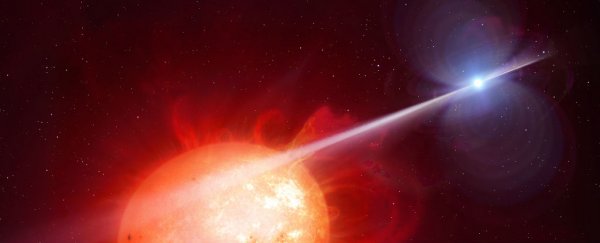Scientists have finally laid eyes on the first white dwarf pulsar in the known Universe, and while the star is roughly the size of Earth, it's got 200,000 times more mass, and an electromagnetic field 100 million times more powerful.
Until now, the thousands of pulsars that have been discovered all formed the same way - the core of a massive star explodes, and collapses into a spinning neutron star. But this new pulsar is something completely different, and it's been eluding astronomers for over half a century.
The first pulsar was identified by accident back in the 1960s when astronomers were looking for extragalactic radio sources.
At the time, the team expected the pulsar to be a type of white dwarf star, but when they analysed a pulsar at the centre of the famous Crab Nebula, they realised no white dwarf could vibrate or spin that fast - it had to be a neutron star.
The difference between neutron stars and white dwarfs stems from the way they're formed - both are burnt-out stellar remnants, but white dwarfs are the result of low mass stars quietly collapsing, and neutron stars are formed in the catastrophic collapse and supernova explosion of a massive star.
Due to the difference in their initial mass, neutron stars have higher temperatures at formation, spin faster, and have stronger magnetic fields than white dwarfs.
The discovery of the first pulsar not only confirmed that they were a type of neutron star, but that neutron stars actually do exist - something astronomers had predicted 30 years prior.
Since then, researchers have theorised that pulsars could also play a role in binary systems - a system of two astronomical bodies that are so close, their gravitational attraction causes them to orbit each other around a common centre of mass.
Within these binary systems, it was predicted that a neutron star, a main sequence star (like our Sun), or a white dwarf star could be involved, and now astronomers have finally identified a real life example of the latter.
The team from the University of Warwick in the UK and the South African Astronomical Observatory identified the star AR Scorpii (AR Sco) as the first white dwarf version of a pulsar, and at 380 light-years from Earth, it's a fairly close neighbour to us - in astronomical terms.
"The new data show that AR Sco's light is highly polarised, showing that the magnetic field controls the emission of the entire system, and a dead ringer for similar behaviour seen from the more traditional neutron star pulsars," Tom Marsh from the University of Warwick explains.
And although white dwarfs came from much lower mass stars than neutron stars do, this thing is anything but a shrinking violet.
The researchers describe the binary system as a white dwarf pulsar blasting its red dwarf neighbour - a class of dim or failed stars - with powerful beams of electrical particles and radiation relentlessly every 2 minutes.
No one's seen anything quite like it in the Universe before.
"AR Sco is like a gigantic dynamo: a magnet, [the] size of Earth, with a field that is ~10,000 stronger than any field we can produce in a laboratory, and it is rotating every 2 minutes," says another of the Warwick team, Boris Gänsicke.
"This generates an enormous electric current in the companion star, which then produces the variations in the light we detect."
Now that we've identified our first white dwarf pulsar, scientists will be better equipped to search for others like it.
At this stage, it's not clear how rare these things actually are, but it might be time to go back and investigate the white dwarfs we do know about, to check for that tell-tale spin.
The study has been published in Nature Astronomy.
